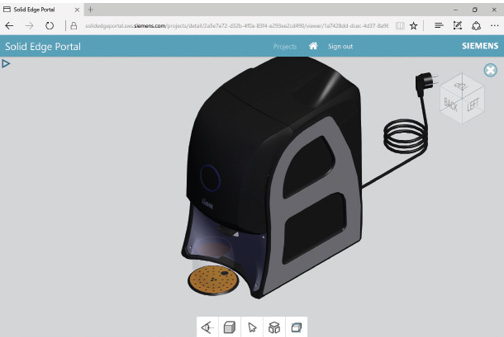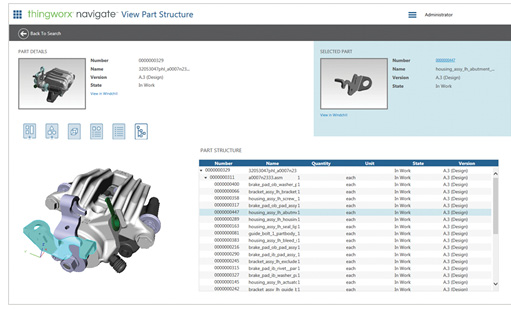
Solid Edge Portal allows users to upload their designs and maintain fully associative parts lists for easy project accessibility and part visualization. Image courtesy of Zumex Group and Majenta PLM.
Latest News
February 1, 2018
For more than two decades, PLM proponents pushed the platform as the single repository for product design—the hub for an extended design team to share materials and engage in collaboration. Yet the reality was often notably different: Traditional PLM was far too unwieldy for many organizations and its functionality catered to the engineering department’s specific needs, not necessarily to the broader enterprise or even to an extended chain of partners.
Enter the new age of PLM, where technologies like the cloud, improved visualization, lightweight sharing capabilities and role-based experiences are being leveraged to open up the platform to a far broader audience. In particular, many new PLM offerings, along with remodeled versions of the original behemoth PLM platforms, are introducing functionality aimed specifically at facilitating extended design chain collaboration—a necessity given the complexity of today’s multidisciplinary products.
Whether you’re talking about the latest vehicle design or a smart home device, the makeup of today’s modern products demands different expertise and different workflows than in the past. Many in the extended ecosystem don’t have access to enterprise PLM and even more don’t have interest in learning how to use the complex systems. Moreover, downstream users in procurement or service, for example, need access to product-related data that often has never made its way into the core PLM backbone.
“There are a lot of partially developed PLM systems that are missing a lot of data,” says James White, practice director, additive manufacturing at CIMdata. “A lot of what’s required for product lifecycle management involves objects, documents, files and metadata that is outside of the engineering department. There’s a recognition that much of the content is coming from other places.”
 Solid Edge Portal allows users to upload their designs and maintain fully associative parts lists for easy project accessibility and part visualization. Image courtesy of Zumex Group and Majenta PLM.
Solid Edge Portal allows users to upload their designs and maintain fully associative parts lists for easy project accessibility and part visualization. Image courtesy of Zumex Group and Majenta PLM.Traditional PLM players and newcomers are hard at work trying to change that dynamic by making it easier to tap into data silos and orchestrate collaboration workflows.
“The issue with traditional PLM over the last 10 to 15 years is that it’s been focused on capturing and storing information related to product development—it’s not been about sharing information,” adds Francois Lamy, VP of solution management for PTC’s IoT Solutions Group. “Most of the people accessing PLM are the people that put information into PLM. Because PLM has mostly been deployed on premise, behind the firewall, it’s made it difficult to bring outside people in. It’s possible, but it’s not been easy.”
New Technologies to the Rescue
At PTC, there is a multipronged strategy to make PLM more accessible to a wider audience. At a base level, the company now offers a subscription pricing model (see DE article here) to give customers more flexibility in planning PLM usage, Lamy says, and it’s also seeing more of its PLM customers deploy the Windchill PLM platform in the cloud, which can optimize costs, facilitate deployment, and most importantly, make extended collaboration easier.
Beyond those steps, PTC has modified how it views PLM—instead of a single repository or one version of the truth (both old PLM catchphrases), it now views PLM as a system of engagement, which can tap into information from other systems. “As more of the organization gets involved in product development, the problem of collaboration becomes more important,” Lamy explains. “That doesn’t mean all the information has to be in one system. We are trying to make it easier for people to access information inside of different systems of record.”
Those systems of record, ERP, CRM, MRP or even another PLM system, can be accessed through Navigate, a series of smartphone-style apps that make role- and task-specific PLM data available to all participants in the product lifecycle. Leveraging ThingWorx connectivity and rapid application development capabilities, PTC Navigate provides a library of tasks, which can be configured to create workflows to support specific roles.
Given its stake in augmented reality (AR) via its acquisition of Vuforia (see DE article here), PTC is also exploring how to leverage AR in design reviews.
At Siemens PLM Software, another PLM giant, work has been underway to make PLM capabilities more accessible to smaller companies, particularly those that haven’t had any PLM or product data management (PDM) systems, notes Dan Staples, Siemens’ VP of mainstream engineering R&D. Although Teamcenter remains the Siemens PLM platform of choice for large enterprise customers, it’s the smaller companies, many lacking full-time database administrators, that have been underserved by traditional PLM—exactly the constituency Siemens is targeting with Solid Edge ST9 version, according to Staples.
Solid Edge ST9 offers a cloud-based licensing option, built-in data management capabilities and the ability to leverage popular tools like Dropbox, OneDrive, Box and Google Drive as data storage options that offer cloud-enabled vaulting and anywhere access for sharing design data. Without a full-blown SQL database at its core, a requirement of most traditional PLM systems, smaller firms can get up and running quickly without requiring assistance from a database administrator, Staples says.
The compatibility with cloud storage and sharing tools, in particular, does a lot to facilitate collaboration. “An engineer in Huntsville, AL, can open a file for write access and it’s immediately locked for a peer engineer in China for write access,” he explains. “That means suddenly small businesses can get involved in collaborating on a geographically dispersed basis. Before with traditional PLM, it was expensive replication or a free for all. What we want to get to is managed collaboration.”
 Navigate leverages ThingWorx’s connectivity and rapid development capabilities to tap into different systems of record. Image courtesy of PTC.
Navigate leverages ThingWorx’s connectivity and rapid development capabilities to tap into different systems of record. Image courtesy of PTC.Siemens PLM Software has also released the free Solid Edge Portal for cloud-based project collaboration. Users can upload CAD files to the cloud, organize them into projects, view and share 3D models securely and selectively with other engineers and partners, Staples says. The portal offers extensive 3D viewing capabilities like 3D pan, zoom and rotate, and 3D cross-sections.
Aras, a one-time fringe PLM player, has made its way into some of the largest OEM customers in the aerospace and automotive sectors because its open PLM platform is more flexible for engaging constituents beyond engineering in active collaboration, according to Doug MacDonald, product marketing director for the firm. Aras Innovator’s model-based service-oriented architecture (SOA), which includes an open data model, open interfaces and open web standards, enables rapid implementation and easy configuration of specific workflows not to mention the ability to scale to accommodate large numbers of PLM users without degrading performance, MacDonald says.
Because of this flexibility, customers are overlaying Aras Innovator onto their existing PLM deployments, typically focused on CAD data management and related processes, to handle specific workflows, MacDonald says.
“We’ve optimized our architecture to make it flexible and easy to use rather than building in specific ways of doing things,” he says. “So instead of us telling customers how to manage the lifecycle, the customer can define how to do those processes.”
Upchain, a startup in this space, is positioning its cloud-based platform specifically as a PLM alternative that allows engineers, designers, salespeople and procurement specialists to collaborate more effectively. The firm, initially a consultant in the automotive supply chain, developed its core technology to address the challenges suppliers faced trying to manage product development cycles involving large customers across multiple locations. Many of its customers were dealing with a lack of unified global systems, which made sharing engineering CAD files difficult and created obstacles as part naming conventions varied across the myriad systems and locations.
The Upchain solution is based on a proprietary “decoder ring” that enables CAD files to be uploaded, stored and shared easily across users and projects, regardless of the file format, says John Laslavic, CEO and founder. Upchain also spent a lot of development energy on creating a user experience that allows users to be versed in the system within hours, he says.
With industry estimates that only a fraction of companies have deployed PLM, Upchain and other PLM providers see an opportunity to expand their ranks by focusing on collaboration. “Seventy percent of CAD users in the world need something for collaboration and don’t have anything other than shared drives, Excel spreadsheets or functionality from their ERP systems to make it work,” Laslavic says. “We think of it as the democratization of engineering and PLM—allowing people, no matter who they are or where they are working, to collaborate.”
More Info
Subscribe to our FREE magazine, FREE email newsletters or both!
Latest News
About the Author
Beth Stackpole is a contributing editor to Digital Engineering. Send e-mail about this article to [email protected].
Follow DE





